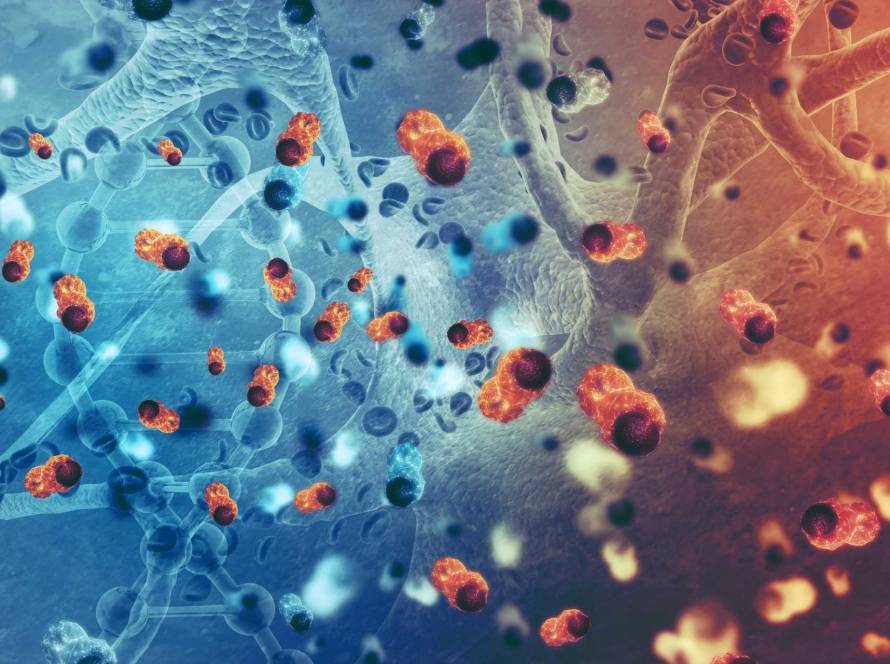Lysosomes are the most underappreciated heroes in our cellular world. Knowing their significance reveals their profound effect on human longevity. In this piece, we dive into the fascinating world of lysosomes, why are they important and their vital role in cellular health and longevity.
What role do lysosomes play in keeping cells healthy?
Lysosomes are important because they act like the cell’s recycling center, breaking down waste, damaged parts and harmful invaders. This keeps cells clean and working properly.
Without lysosomes, old or toxic materials would build up, leading to cell damage or disease. They also play a big role in defending the body from infections and help the cell renew itself through a process called autophagy. For these reasons, lysosomes are essential for keeping our cells, and our bodies, healthy.
Understanding the function of lysosomes in cells
Our bodies function thanks to an amazing microscopic world of cells filled with remarkable machinery. Among the most crucial parts of this cellular infrastructure are lysosomes that perform vital tasks at life’s most basic level.
What do lysosomes do in simple terms?
Think of lysosomes as specialized recycling centers in cells that come with powerful digestive abilities. These membrane-bound organelles contain approximately 50 different hydrolytic enzymes that break materials down into their simplest building blocks. We can think of lysosomes as the cell’s digestive system that processes everything from proteins and nucleic acids to carbohydrates and lipids.
Lysosomes interior stays highly acidic with pH between 4.5-5.0, which lets enzymes work at their best. Proton pumps manage to keep this acidity by moving H+ ions from the cytosol into the lysosome. The acidic environment creates ideal conditions for enzymes and protects the rest of the cell. If these enzymes leak out, the neutral pH of the cytoplasm would make them inactive.
Why lysosomes are important to the health of cells
Cells cannot survive without lysosomes because they:
- Break down materials from outside the cell through endocytosis or phagocytosis;
- Process worn-out cell parts through autophagy for cellular renewal;
- Fight off invading pathogens like bacteria and viruses for cellular defense;
- Turn old materials into building blocks for new cellular components;
- Act as signaling hubs that share nutritional information.
Lysosomes also help repair damaged plasma membranes. Cells would fill up with waste products and damaged components without working lysosomes, which would lead to their dysfunction and death.
How lysosomes help maintain homeostasis
Lysosomes are central to keeping cells in balance, a state called homeostasis that cells need to work properly. They do this through coordinated breakdown and recycling processes that adapt to what cells need.
When nutrients are scarce, lysosomes step up autophagy to break down non-essential parts for energy and materials. This helps cells survive periods when food is limited by recycling their contents. Lysosomes also balance cell metabolism by detecting available nutrients and adjusting how cells respond.
Lysosomes do more than regulate metabolism. They control calcium levels and cell signaling pathways. They work together with other organelles like mitochondria and the endoplasmic reticulum, creating an interconnected system that keeps the cell balanced.
The importance of lysosomes becomes clear when we look at lysosomal storage diseases. These conditions show how enzyme deficiencies lead to toxic buildup of unprocessed materials and severe physical damage.
The many roles lysosomes play in cellular health
Lysosomes sit at the intersection of cellular metabolism and defense and they have many functions that are vital to cellular health. These versatile organelles work as the cell’s multitasking specialists, with responsibilities that go way beyond simple waste disposal.
Breaking down damaged organelles and proteins
Lysosomes play a significant role in cellular quality control by orchestrating the removal of worn-out organelles through specialized forms of autophagy. This process has several types: mitophagy breaks down mitochondria, reticulophagy handles the endoplasmic reticulum, pexophagy takes care of peroxisomes and ribophagy deals with ribosomes. These processes stop dysfunctional organelles from building up, which could release harmful substances or waste valuable resources.
Lysosomes use two main mechanisms to break down proteins. The first is general proteolysis, where various cathepsins (lysosomal proteases) break proteins into amino acids. The second is the chaperone-mediated autophagy pathway, which targets specific proteins with a KFERQ-like motif. HSPA8/HSC70 chaperones recognize these proteins and deliver them straight to lysosomes through the LAMP2A receptor1
Fighting infections by digesting invaders
Lysosomes work as frontline defenders against pathogens. When specialized cells like macrophages engulf bacteria through phagocytosis, they form phagosomes. These phagosomes join with lysosomes to create phagolysosomes where hydrolytic enzymes destroy the invaders.
Lysosomes help immunity through toll-like receptors (TLRs) that detect viral and bacterial nucleic acids. TLRs 3, 7, 8 and 9 recognize different pathogen nucleic acid patterns and trigger cytokine production and immune responses. Lysosomes also process antigens to present them on MHC-II molecules, which is vital for adaptive immunity.
Recycling nutrients and supporting metabolism
These cellular recycling centers break down macromolecules into reusable building blocks. The products, amino acids, lipids, sugars and nucleotides, move across the lysosomal membrane for the cell to reuse.
Recycling becomes especially important for amino acid balance. Specialized transporters move newly recycled amino acids like leucine to the cytosol, which enables protein synthesis. Lysosomes also process LDL cholesterol and free up sterols and fatty acids for membrane creation.
Regulating autophagy and aging
Complex signaling networks centered around mTORC1, a master growth regulator, help lysosomes control autophagy. mTORC1 stops autophagy when nutrients are available. During starvation, mTORC1 becomes inactive, which promotes autophagy and helps increase lifespan.
The cell has three different types of autophagy: macroautophagy forms autophagosomes, microautophagy involves direct lysosomal engulfment of cytosolic material chaperone-mediated autophagy selectively breaks down KFERQ-motif proteins. These processes remove cellular waste that builds up as we age.
Controlling calcium levels and signaling
Lysosomes are the second largest calcium store in cells. They maintain about 500-600 μM free calcium concentration, roughly 5000-6000 times higher than cytosolic levels. This calcium reservoir is vital for membrane fusion, vesicle trafficking and signaling pathways.
Various channels like TPCs (Two-Pore Channels) and TRPML1 (Transient Receptor Potential Mucolipin 1) regulate lysosomal calcium. These channels aid calcium release that triggers calcineurin activation and TFEB dephosphorylation. This allows TFEB to enter the nucleus and increase the production of genes needed for lysosomal biogenesis and autophagy.
Lysosomal dysfunction and its impact on the body
Many devastating diseases share a common root cause: dysfunctional lysosomes. These cellular recycling centers can trigger a chain reaction throughout the body when they fail. The failure disrupts multiple organ systems and speeds up biological aging.
Overview of lysosomal storage diseases
Lysosomal storage diseases (LSDs) include more than 70 inherited metabolic disorders caused by enzyme deficiencies. These deficiencies prevent complex molecules from breaking down properly. Genetic mutations that affect lysosomal enzymes, membrane proteins or activators cause these conditions.
LSDs have severe effects on patients. The central nervous system takes the biggest hit, along with damage to other organs. Undegraded substances build up and set off complex disease processes. These include disrupted vesicle trafficking, autophagy problems, calcium imbalances mitochondrial dysfunction.
Lysosomes and Alzheimer’s, Parkinson’s and ALS
Lysosomal dysfunction does more than cause rare genetic disorders, it plays a key role in common brain diseases. Alzheimer’s disease involves mutated presenilin-1 that makes lysosomes too alkaline by blocking v-ATPase assembly. This blocks protein breakdown. Both amyloid precursor protein and presenilin-1 mutations lead to lysosomal problems.
Parkinson’s disease links to GBA gene mutations, which usually cause Gaucher disease in people with two copies. These mutations lower glucocerebrosidase activity and cause α-synuclein to build up.
ALS patients’ motor neurons show unusual buildups of glycosphingolipids and autophagic vesicles. Studies show their brain tissue shows about a 62% drop in nuclear TFEB, the key controller of lysosomal genes.
How lysosomal failure accelerates aging
Lysosomes become less efficient as we age, setting the stage for age-related diseases. This decline shows up as:
- Lipofuscin (waste material) building up in lysosomes;
- Cathepsins and other digestive enzymes becoming less active;
- Lysosomal walls breaking down and losing their acidity;
- Less chaperone-mediated autophagy because of lower LAMP2a levels.
Life-extending treatments across different species share an interesting feature, they make lysosomes work better.
The link between lysosomes and chronic inflammation
Broken lysosomes contribute to chronic inflammation in several ways. They leak cathepsins into cells, which triggers inflammatory cell death. Cells also can’t completely digest pathogens or cellular debris, which keeps inflammation going.
Scientists see lysosomes as promising targets for new treatments.
Ways to improve lysosomal function naturally
Scientists have discovered several natural ways to boost lysosomal function, which could slow down aging and reduce disease risks. Lysosomes play a crucial role in cellular health, so making them work better offers a promising path to living longer.
Benefits of intermittent fasting
Intermittent fasting activates lysosomal function through several mechanisms. This eating pattern restores autophagic flux in cells, even when people eat high-fat diets that usually block autophagy. Studies show that fasting triggers transcription factor EB (TFEB), which controls lysosomal creation and turns on genes needed for autophagy. People who fast from dawn to dusk for four weeks show substantially higher levels of key autophagy genes. Fasting also helps lysosomes become better at sensing nutrients and coordinating how cells respond to environmental changes.
How exercise boosts lysosomal activity
Physical activity makes lysosomes work better through multiple pathways. Working out activates TFEB and TFE3 transcription factors that boost lysosomal and autophagic genes. This happens in part because exercise creates more mitochondrial reactive oxygen species (ROS), which boost TRPML1-mediated calcium release from lysosomes. Research on mammals and fruit flies proves that endurance exercise increases lysosomal activity and helps clear damaged mitochondria during stress. This preserves brain function as we age. The protein Sestrin plays a vital role in how exercise improves lysosomal function.
Nutrients and supplements that support lysosomes
Some compounds make lysosomes work better directly. Resveratrol, which we can find in grapes and nuts, triggers calcium signaling that activates TFEB. This promotes autophagy and creates more lysosomes. Vitamin D3 helps lysosomes break down materials by moving protein complexes into the nucleus, which improves calcium channels and keeps lysosomes acidic. Trehalose, a natural sugar, starts autophagy without using mTOR by activating AMPK pathways and helping proteins fold correctly.
Reducing exposure to harmful chemicals
Nanoparticles can damage lysosomes severely. They disrupt acidification, break membranes and interfere with important proteins. We can protect our lysosomes by limiting our exposure to manufactured nanomaterials in everyday products. Avoiding environmental toxins that damage lysosomal membranes and enzymes matters just as much.
Future therapies targeting lysosomal pathways
New treatments aim to boost natural lysosomal processes. Scientists see promise in targeting specific parts of the autophagy-lysosomal pathway to treat brain diseases. Ketogenic diets create ketones that fuel the brain while making lysosomes more acidic through AMPK activation. Researchers continue to study drugs that could safely increase TFEB activity without disrupting the cell’s balance.
Lysosomes work as our cells’ quality control department, though many overlook their role in cellular health. Simple lifestyle changes can maintain these organelles properly, one of the most available ways to influence biological aging at the cellular level. These microscopic organelles clearly play a crucial role in determining overall health outcomes. The strategies outlined in this piece offer science-backed methods to optimize cellular health and support the complex recycling systems that keep our biological machinery running smoothly.


